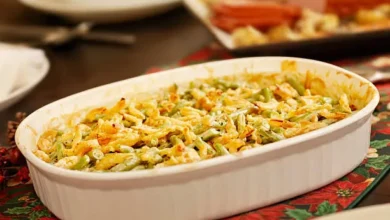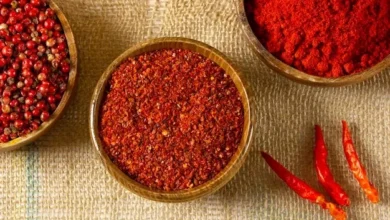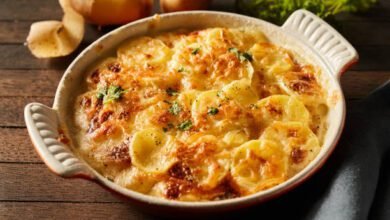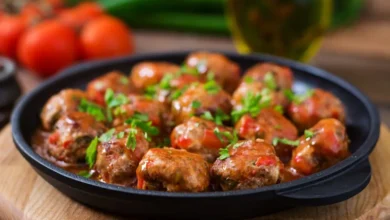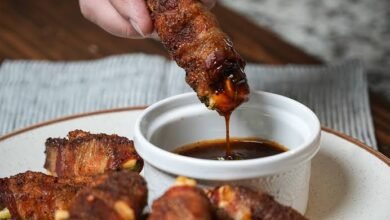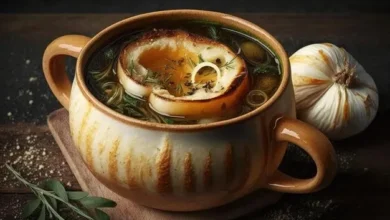Grilled Ribeye Steak With Homemade Cowboy Butter Recipe
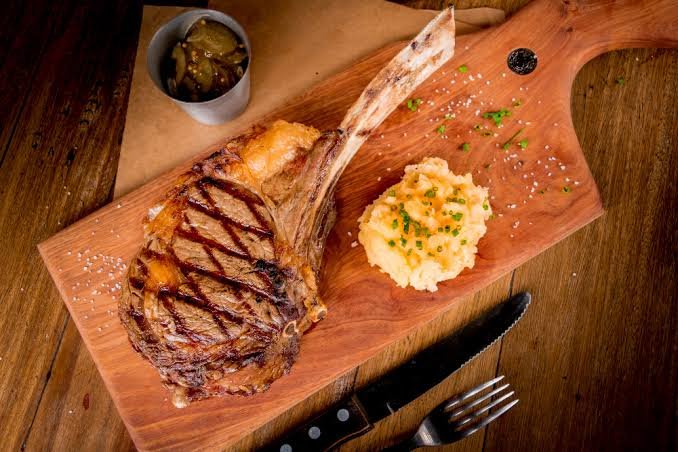
Nothing can quite match the anticipation of an upcoming steak night at home. Fire up the grill to cook up a juicy ribeye steak, you can’t help but daydream of the restaurant-worthy dining experience awaiting inside. But the real magic happens when you bring out homemade cowboy butter. A blend of fresh herbs, spices and loads of garlicky goodness come together to create a compound of bursting flavor. A small dollop of the delicious butter is all it takes to elevate perfectly cooked steak from good to great, infusing each and every bite with an irresistible touch of smoky heat as the butter melts over the hot meat.
Contents
- Grilled Ribeye Steak With Cowboy Butter
- What is Cowboy Butter?
- How to Make Homemade Cowboy Butter?
- Choosing the Right Steak
- What is the Best Method to Grill a Thick Steak?
- Steak Thickness and Cooking Time
- Internal Temperature Guide for Grilled Steak
- How to Make Grilled Ribeye Steaks With Cowboy Butter?
- Importance of Resting Your Steak
- How to Serve These?
- Frequently Asked Questions (FAQs)
- Do I have to use a ribeye steak?
- Can the cowboy butter be used on anything else?
- Why is it called ribeye steak?
- What to serve with ribeye steaks and cowboy butter?
- How long do you grill cowboy ribeyes?
- Is it good to put butter on steak before grilling?
- What is the difference between a cowboy ribeye and a ribeye steak?
- Is a cowboy ribeye steak tender?
- Is ribeye the tastiest steak?
- Grilled Ribeye Steak With Cowboy Butter
Grilled Ribeye Steak With Cowboy Butter
This article is your one-stop shop for creating a restaurant-worthy grilled ribeye steak infused with the magic of cowboy butter. We’ll delve into what cowboy butter is, how to craft your own delicious flavor bomb, and also guide on selecting the perfect thick-cut ribeye steak to star as the masterpiece their grilling technique will help them create. Tips will be shared for mastering the grilling technique to guarantee a thick-cut ribeye cooked to grilled ribeye perfection, complete with the melting goodness of their own homemade cowboy butter dolloped on top.
What is Cowboy Butter?
Cowboy butter is a catch-all term for a flavorful compound butter that takes any ribeye steak recipe to the next level when slathered on top. At its simplest, it’s a spicy garlic and herb butter that adds incredible versatility, whether served melted over a hot steak straight off the grill or slathered onto a classic cold cut of ribeye. Bite into a ribeye coated in the confection of cowboy butter, and your wildest food dreams have come true.
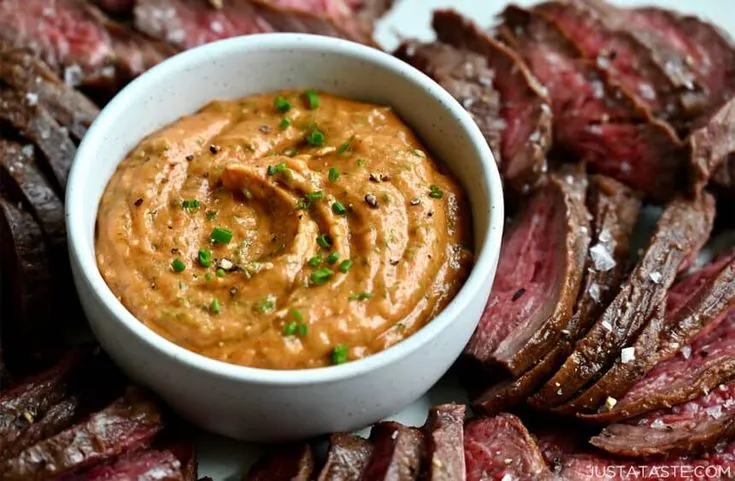

This flavor bomb of a butter is made by mixing together ingredients like lemon juice, red pepper flakes, fresh herbs like chives or parsley, black pepper and brown mustard into softened butter until fully combined. Once pressed together into a log, it’s the perfect, delicious complement that goes especially perfect with grilled steak. Man, oh man, is this good butter ever going to intensify the flavors and take your dinner details to the next level.
How to Make Homemade Cowboy Butter?
Cowboy butter is a flavorful herb and spice compounded butter that perfectly elevates any grilled or seared meat to new heights. While there are many variations, this specific recipe creates a delicious balance of savory, slightly spicy flavors that will complement a juicy ribeye steak just right. For detailed instructions and a complete list of ingredients, see my recipe for homemade cowboy butter.
Choosing the Right Steak
While this recipe calls for ribeye steaks, which are highly flavorful, however you’re certainly not limited to that cut and can select another based on your preference. When choosing a steak, aim for a thicker cut around 1 1/2 to 2 inches to ensure the exterior sears up nicely before the interior cooks through.
Marbling, or the distribution of fat throughout the meat, greatly impacts flavor, so look for a generous marbling. Steaks labeled USDA Prime offer the highest marbling quality but will be more expensive. USDA Choice cuts, especially from the loin or rib, also exhibit good marbling content at a lower price point and will perform well in this recipe.
What is the Best Method to Grill a Thick Steak?
When cooking a thick steak, the reverse sear method is highly recommended. If placed directly over hot charcoal or gas, thick steaks are prone to cooking unevenly or burning on the outside from frequent flipping. Reverse searing allows the steak to cook low and slow over indirect heat first, preventing exterior burning while the interior reaches temperature evenly.
Once close to desired doneness, searing over direct high heat finishes and crisps both sides. I find this method results in a juicier steak every time when paired with my Cowboy Butter recipe. Just be sure to leave your evening open afterward – one of these steak dinners is guaranteed to send you straight into a satisfied food coma!
Steak Thickness and Cooking Time
The thickness of the steak will significantly impact cooking times when using the reverse sear method. Here are some more general guidelines based on steak thickness and a starting grill temperature of 250°F:
| Steak Thickness | Estimated Cooking Time (to 120°F internal temperature) |
| 1 inch | 20–30 minutes |
| 1 1⁄2 inches | 30–40 minutes |
| 2 inches | 40–60 minutes |
| 2 1⁄2 inches | 50–70 minutes |
It’s important to note that these estimates may vary depending on factors like the specific cut of meat, grill temperature fluctuations, and desired level of doneness. It is crucial to use a reliable instant-read thermometer to monitor the internal temperature for accurate results.
Internal Temperature Guide for Grilled Steak
While the reverse sear method initially aims to cook the steaks over indirect heat until they reach an internal temperature of 120°F, this is just the first step. Here are some general guidelines for steak doneness based on internal temperature:
| Doneness | Internal Temperature | Description |
| Rare | 120°F – 130°F | Seared on the outside, cool red center |
| Medium Rare | 130°F – 135°F | Warm pink center |
| Medium | 140°F – 145°F | Slightly pink center |
| Medium Well | 145°F – 150°F | Mostly cooked through with a hint of pink |
| Well Done | 150°F and above | Cooked all the way through |
Remember: Achieving the perfect doneness for your grilled steak requires paying close attention to internal temperatures. It’s important to remember that a steak’s temperature will continue to rise slightly even after removing it from the direct heat source. For this reason, it’s best to consider taking steaks off the grill a few degrees below your desired final temperature to account for carryover cooking during the resting period.
How to Make Grilled Ribeye Steaks With Cowboy Butter?
While this recipe calls for ribeye steaks, you could use tomahawks which are essentially a ribeye on a long bone, making for a beautiful presentation. Choose ribeyes with good marbling and a nice fat cap.
Allow the steaks to come to room temperature before coating them lightly with olive oil, and generously season both sides with kosher salt and black pepper. I like using kosher salt because I like to see the big flakes on the surface of the meat. You can also season with my homemade beef rub.
Preheat your grill to around 250°F for indirect cooking. Place a ceramic heat deflector under the grill grates to block direct heat from the source, as indicated for indirect cooking.
If using a charcoal grill, bank the coals to one side and place the steaks on the opposite side away from the heat. For gas grills, leave the burners directly under the steaks turned off and place the steaks as far from the heat source as possible. Add wood chips or chunks to the coals to impart some smoke flavor if desired.
Cook the steaks until they reach an internal temperature of 120°F, about 40–60 minutes. Then remove the heat deflector and sear the steaks directly over the hot coals or burners for a few minutes, flipping them a couple of times for a nice crust on both sides Before removing from the grill, I like to top each grilled steak with a few pats of melting cowboy butter.
Importance of Resting Your Steak
It is very important to rest your steak after cooking to allow the juices to redistribute throughout the meat before digging in. Otherwise, the juices will not have a chance to redistribute back into the meat and may spill out onto your cutting board when sliced.
For the best eating experience and maximum flavor, be sure to rest steaks for the recommended times. For most ribeyes under an inch and a half thick, a 10-minute rest time is sufficient. But for larger, thicker cuts like a tomahawk steak, you’ll want to extend the rest to 15–20 minutes to allow full reabsorption of juices from the exterior back into the steak’s interior. It’s important to note that the recommended resting time should increase along with the thickness of the steak:
| Steak Thickness | Recommended Resting Time |
| Under 1 1/2 inches | 10–15 minutes |
| 1 1/2–2 inches | 15–20 minutes |
| Over 2 inches | 20–25 minutes |
It’s important to note that letting the steak rest is a crucial step to ensure the most enjoyable eating experience and to allow the steak to reach its maximum flavor and juiciness.
How to Serve These?
To serve, slice the rested steak across the grain, so each piece retains optimal tenderness. Feel free to top each slice with a bit more melted cowboy butter as you transfer to plates. You can even offer a side of dipping sauce for guests to enjoy with their steak.
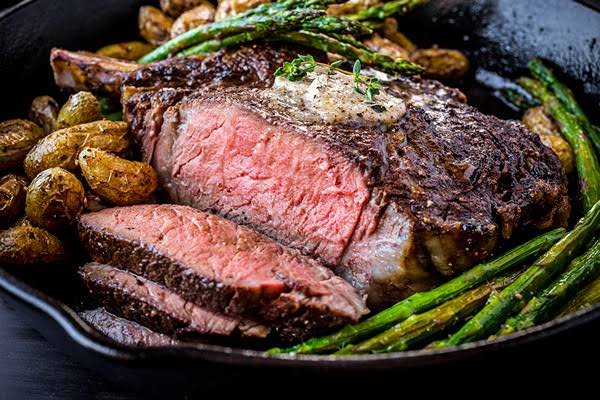

Wrapping It Up
Having successfully executed this recipe, you now know how to make one of life’s true steakhouse pleasures – a juicy, perfectly grilled ribeye coated in melty, herbaceous cowboy butter. Like me, I hope this becomes one of your favorites to cook for friends and family around the grill. Dig in and enjoy every savory, indulgent bite! With high quality ingredients and this technique, you truly can achieve restaurant-quality results from the comfort of your own backyard.
————————————
Frequently Asked Questions (FAQs)
Do I have to use a ribeye steak?
No, you’re not limited to using ribeye steak for this recipe. Any well-marbled cut will work well. Other good options include New York strip, filet Mignon, T-bone or porterhouse steaks. Just cook times may vary depending on thickness and cut.
Can the cowboy butter be used on anything else?
Yes, cowboy butter is extremely versatile and delicious on more than just steak. Some other great uses include topping grilled or roasted vegetables, bread, potatoes, or seafood like salmon. You can also slather it on steaks that aren’t necessarily ribeyes.
Why is it called ribeye steak?
A ribeye cut comes from the rib section of the cow, which has excellent marbling (streaks of fat). The sections of back muscle that make up this cut are called the longissimus dorsi, or “long muscles of the back.” Over the years, ribs became a popular cut, hence the term “ribeye.”
What to serve with ribeye steaks and cowboy butter?
Ribeye is a rich cut that pairs well with sides like baked potatoes, sautéed mushrooms, grilled asparagus or green beans. It also stands up to bold sauces, so cowboy butter is a natural fit. A salad or bread complements the meal too.
How long do you grill cowboy ribeyes?
Cooking times depend on thickness but generally 30–60 mins over indirect heat until 120°F internal temp, then 3–5 mins per side searing is a good guideline. Thicker cuts may take 60+ mins indirect. Use a thermometer for best results.
Is it good to put butter on steak before grilling?
Yes, applying compound butters like cowboy butter to steak before grilling allows the fat and flavors to baste the meat as it cooks. It leads to juicier, more tender steak. Just be sure not to over butter, or it may cause flare-ups. A light coating is all that’s needed.
What is the difference between a cowboy ribeye and a ribeye steak?
There is no difference – “cowboy ribeye” is just a name used for marketing that emphasizes the steak’s rich marbling and flavor. But fundamentally, it refers to the same ribeye cut of beef.
Is a cowboy ribeye steak tender?
Yes, ribeye steak is naturally very tender due to its marbling (intramuscular fat). Cooking the steak to no more than medium-rare using the reverse sear method helps ensure it stays juicy and tender, too. The cowboys of old knew ribeyes were one of the most buttery, tender cuts for their camps.
Is ribeye the tastiest steak?
Ribeye is often considered one of the most flavorful steaks cuts due to its heavy marbling, which leads to a rich, beefy flavor. The thicker fat strands melt during cooking to keep the steak moist and add decadent flavor. For these reasons, many consider ribeye to be the most coveted, delicious steak.
Grilled Ribeye Steak With Cowboy Butter
Course: Grilled MeatsCuisine: American4
servings15
minutes1
hour665
kcal1
hour15
minutesIndulge in the decadence of a juicy grilled ribeye steak topped with a savory herb butter blend. A dollop of homemade Cowboy Butter takes this steak dinner to a whole new level of flavor.
Ingredients
1 16 oz Ribeye steak or 2 8 oz steaks
1 tablespoon olive oil
1 tablespoon salt and pepper (Or homemade beef rub)
Directions
- Choose ribeyes with good marbling and a nice fat cap. Allow the steaks to come to room temperature before coating them lightly with olive oil.
- Season both sides with kosher salt and black pepper. Or you can also season with my homemade beef rub.
- Preheat your grill to around 250°F for indirect cooking. Place a ceramic heat deflector under the grill grates to block direct heat from the source, as indicated for indirect cooking.
- Cook the steaks until they reach an internal temperature of 120°F, about 40–60 minutes. Then remove the heat deflector and sear the steaks directly over the hot coals or burners for a few minutes, flipping them a couple of times for a nice crust on both sides. Before removing from the grill, top each grilled steak with a few pats of melting cowboy butter.
- For the best eating experience and maximum flavor, be sure to rest steaks for 10-minutes. Slice the rested steak across the grain, so each piece retains optimal tenderness.
- Feel free to top each slice with a bit more melted cowboy butter as you transfer to plates. You can even offer a side of dipping sauce for guests to enjoy with their steak.

